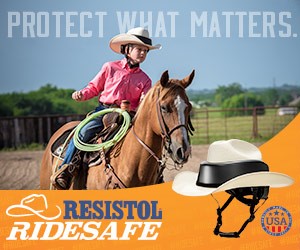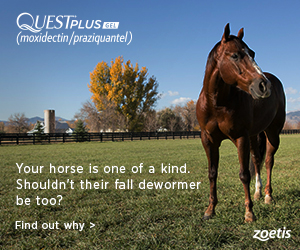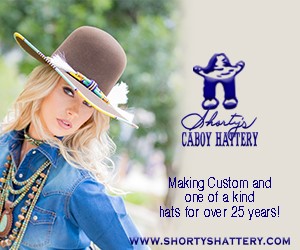DISCIPLINE 101
Showmanship is about being confident, having fun and training a responsive horse.
By Robbie McCommas
Is there a secret to being great at showmanship? multiple AQHA world champion Tony Anderman of Saint Cloud, Minnesota, says there is, and he’s willing to share it.
“This sounds simple, but it really is the basis of the class: Have confidence in your preparation and your plan for executing the pattern, and sell that to the judge,” Tony says.
He offers the following definition for his class of choice: “Showmanship is exhibiting your horse on the ground through a predesignated pattern. Maneuvers may include walking, trotting, pivoting, backing and setting up.”

Showmanship is really like choreography for an exhibitor and their horse – moving, stepping in sync.
According to the AQHA rulebook, showmanship is designed to evaluate the exhibitor’s ability to execute, in concert with a well-groomed and conditioned horse, a set of maneuvers prescribed by the judge with precision and smoothness, while exhibiting poise and confidence, and maintaining a balanced, functional and fundamentally correct body position.
“A good goal for a beginner is being one with your horse and executing the pattern with correctness before adding a level of difficulty in speed,” Tony says.
Being a third-generation competitor, Tony’s exposure to the horse-show world began as a youth. Both of his parents are horse trainers, and his late grandmother was an AQHA judge and an AQHA director from Minnesota. He started his journey in AQHA’s 13-&-Under classes with a green 4-year-old.
Today, competition for Tony includes showmanship, performance halter, hunt seat equitation and horsemanship. These classes commonly pair with a showmanship horse. He had scored several top-10 placings at the AQHA World Championship Show, which prepared him to become the reserve world champion in amateur showmanship in 2012 with his mare, Goodness Im Green.
“My mare and I had been placing well, and we made the finals, but the biggest prize was becoming reserve champion. I realized I really could compete with all these people I had watched and admired! That accomplishment fueled my drive that maybe one day, I could win it.”
A few years later, Tony purchased Solo Invested, a 2004 gelding who had earned a Select world championship in showmanship with Patrick Riley in 2016.
Alhough the horse was already a champion, he and Tony had to become a pair.

Journal photo
Tony Anderman and Solo Invested (A Good Machine-Suzannah Solo by The Invester)
“He’s a little quirky, but he’s a good horse for me,” Tony says. At the 2017 AQHA World Show, the new duo earned their own world championship. By the second year, they won at the All American Quarter Horse Congress in Ohio, the National Snaffle Bit Association World Championship Show and were named AQHA world champions a second time, this time unanimously under all five judges. Tony and Solo Invested added another gold trophy for amateur showmanship at the 2019 AQHA Lucas Oil World Show. He says it’s becoming a bit surreal, but he loves the challenges that showmanship continues to pose.
“The most challenging aspect of showmanship is having a horse that is ultra-responsive but also is patient,” he says. “You want a horse to start backing immediately when asked, but you don’t want him to take off without you. The same in your pivots – you want the horse to start turning as soon as you ask, but not before. It takes being attentive in practice to make sure your horse is quick to react to your cues, but waits for you to implement the cues before reacting.”
Although showmanship can get really refined, it’s also an excellent place for a novice competitor to start.

“The class is great for a beginner horseman,” Tony says. “Being on the ground is not as intimidating as riding, and you can show younger or green horses. This implements good ground manners in a young horse and teaches an individual how to properly handle their horse on the ground.”
So is it necessary to buy that responsive horse? Not at all, Tony says. Practicing showmanship will help any horse.
“Improving the horse that you have takes a lot of practice,” Tony says. “The goal is a light and responsive, willing partner. Getting constructive advice from eyes on the ground from a horse trainer or coach is invaluable. If you don’t have a coach, having someone video to critique your workout is helpful.”
Another DIY tip: Watch more experienced exhibitors and learn from them.
“Interested beginners should attend shows and watch the classes,” Tony says. “There, they will see the finished product, as well as witness that it doesn’t always go so perfect. I encourage showmen to take opportunities to watch people who are really good and see how they are doing it.”
Once you know what you need to be working toward, the important thing is to actually put in the work. Competitors should commit to practicing with their horse several times a week, Tony says. But it’s also important not to drill the horse endlessly.

Make a plan, Tony advises, and set a practice time limit of 10 to 15 minutes. If the horse anticipates, build responsiveness by waiting. The key is to stop and be patient. Make sure the horse is waiting on you to execute the maneuver.
On finished horses, Tony says it’s important to know your horse and practice accordingly. Don’t over-practice, especially at the show. It’s crucial to keep the horse’s interest during the class.
Another pro tip: Show off your horse’s strengths. For instance, if the horse is an exceptional extended trotter, be quick on your feet.
Additionally, be mindful of pattern and arena markers and know where your horse’s shoulder and hip need to be. Have a good eye. Most importantly, the exhibitor needs to be in sync with their horse.
The exhibitor needs to appear business-like, stand and move in a straight, natural and upright manner, and avoid excessive, unnatural or animated body positions.
“Don’t go into the pen and try too hard to overachieve,” Tony says. “However, you can’t go in and wilt because of nerves. Channel the nerves, don’t focus on what other people are doing, focus on yourself and keep on your toes. Just go in, be normal and have fun with it.
“Show your horse to the best of your ability and be proud of the teamwork you’ve accomplished.”
Robbie McCommas is a freelance writer from Agra, Oklahoma. Get AQHA’s free “Showmanship Basics” e-book at www.aqha.com/news-and-publications/e-books/ebooks-overview.

